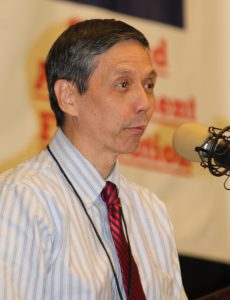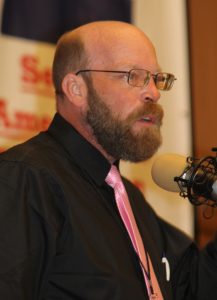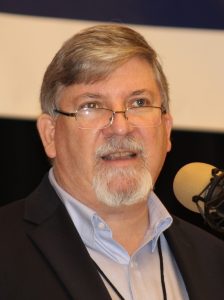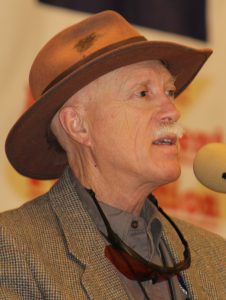By Dave Workman | Senior Editor
One of the most important panel discussions of the 2019 Gun Rights Policy Conference in Phoenix was the one that wrapped it all up; a presentation on using new media to advance the cause of Second Amendment rights.

Charlie Cook
It began with remarks by Charlie Cook, host at “Riding Shotgun with Charlie,” a video effort that began four years ago with Cook playing a trumpet with one hand and firing a gun with the other hand. It caught on quickly and he’s been talking ever since to a growing audience.
Cook explained that his motivation is to bring “fun” ownership to gun ownership. He counseled activists to utilize equipment that is close at hand to make videos such as one involving taking a new shooter to the gun range.
“Put it on social media,” he said. “If something doesn’t work, do something else.”
The idea is to create an audience, reach out to as many people as possible and deliver the message.

Don Irvine
Expanding on Cook’s message was Don Irvine, chairman of Accuracy in Media. He told the audience there are “a lot of great ways to use social media.”
“Besides doing videos,” he suggested, “do a podcast. These are things we are supporting.”
Irvine said such things are possible with smart phones and he offered some tips on getting different apps that make this happen. He also noted that activists can’t ignore existing platforms because they are well-established and people are still using them. Such platforms are still growing and easy to use.
His last piece of advice is to “think about what you post” before it is posted.

Paul Lathrop
Paul Lathrop, host of the Polite Society Podcast, told activists that “old legacy media is dying.”
“Everybody is getting their information on the Internet,” Lathrop said. “All you need is your phone.”
Looking back at the 2000 presidential election, it was decided by a few hundred people in Florida, so Lathrop reminded the crowd, “If we can influence 500 people in one state, we could swing the next election.
He said there is a network of people already involved in the effort and they are willing to help.

John Richardson
John Richardson, author of “No Lawyers, Only Guns and Money,” related how he had been shut down incorrectly by a major search engine for allegedly “facilitating the sale or selling a regulated item.” It took 48 hours from the time he appealed that to hear back from the server that an error had been made and he was good to go.
But in that time Richardson changed his platform, so that it would not happen again.
“We need to do three things,” he advised. “Control your hosting. Don’t depend on companies that would sell us out in a heartbeat.
“We need to explore going back go older technologies,” he continued. A nd we need to seek out newer (technologies.)”
Rights activists cannot allow themselves to be at the mercy of big oligopolies, Richardson cautioned.
To those who do not have their own blogs or podcasts, Richardson said they need to provide existing writers and podcasters with tips and story ideas.

Dean Weingarten
Following Richardson was veteran writer Dean Weingarten with Ammoland, one of the biggest of the gun rights news and commentary sites.
“We are in a great struggle to throw off the yoke of the mediocracy,” he said. “Old media controlled what was considered important issues. They controlled the narrative.”
But that has changed with the new media. He said this is making a difference, and posited that without new media, Donald Trump would not have been elected in 2016.
He had three suggestions. First, record what is happening with digital cameras or recorders, report what you’ve recorded on social media, and comment on news articles and opinion pieces.
“People read the comments,” he said. “If you get attacked personally, it’s a sign you’ve won (the argument).”

Dan Zimmerman
Wrapping things up, Dan Zimmerman at The Truth About Guns said all of the pro-rights news sites are providing people with news they would not get from the establishment media. He asserted that the legacy media only provides one side of the story.
“They never talk about the other side of the equation,” Zimmerman said.
Establishment media doesn’t talk about the many times firearms are used defensively, most of the time without even being fired.
And he also challenged activists to put anti-gunners on the spot. Ask them how many more robberies, rapes or murders they would be willing to allow in order to achieve their goal of public disarmament.
“That’s the other side of the equation,” he said.



